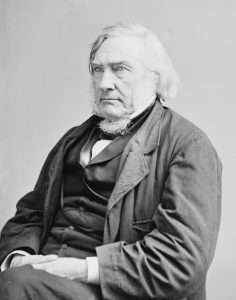The Volokh Conspiracy
Mostly law professors | Sometimes contrarian | Often libertarian | Always independent
Today in Supreme Court History: November 28, 1872
11/28/1872: Justice Samuel Nelson resigns.

Editor's Note: We invite comments and request that they be civil and on-topic. We do not moderate or assume any responsibility for comments, which are owned by the readers who post them. Comments do not represent the views of Reason.com or Reason Foundation. We reserve the right to delete any comment for any reason at any time. Comments may only be edited within 5 minutes of posting. Report abuses.
Please to post comments




Forever associated with chin beards.
One of the interesting things about old photos, like this one, is how different the textiles appear -- the cloth just seems to wrinkle and fold differently. I'm sure much of that has to do with a different weight -- the 1800s were still coming off the Little Ice Age and people wore more and thicker clothes. But part of me thinks there must have been changes in how cloth was manufactured in the last 150 years, and it would be interesting to have and hold freshly manufactured cloth and clothing using old tech and modern tech.
Thanks for this comment.
1. Add to this the fact that heating was done with coal or wood fires, which meant that you were either sweating (near the fire) or cold (everywhere else).
2. There were no synthetic fibers or mercerizing then. Fabrics to be sturdy had to be coarse and thick. See, for example, photos of Henry Moseley, the physicist who died in WW I. Those are seriously thick suits.
3. This was the Victorian era with (to us) ridiculous ideas of modesty. The more clothes, the more civilized.
4. With men (especially) drinking huge amounts of alcohol, and little in the way of what we call exercise, and the diet of a well-off person actually being less healthy (fatty, too much meat, little grain or roughage), the shape of one's body was probably better concealed.
P.S. One lingering legacy of the Little Ice Age, and Victorian England, is the men's suit. Even in a Houston summer, he's expected to wear a tie, long sleeved shirt, jacket, long pants, and shoes with socks. We've gone over some reasons to explain why people like Justice Nelson dressed the way they did. But this makes no sense.
There are a few good books out there on the history of textile and clothing. It is a fascinating read to see how the industry changed especially during the 1900's.
The broadloom techniques used to produce fabrics and textiles was altered significantly in the late 1800's which produced a much more tightly woven product. I was at the Smithsonian once years ago and walked through an exhibit on the history of fabric. Fascinating stuff to compare a garment from the early 1900's to one produced after WWII. Completely different texture, weight, and even look.
"Off the rack" clothing was also not an option until around the 1920's. If you wanted a piece of clothing it was made to your measurements.
The American diet changed a good bit from the 1800's to the 1900's. Men consumed a large amount of alcohol really up until Prohibition. I've seen many estimates but consuming a gallon of whiskey a week was not unheard of in those time. (People say Prohibition was a social policy failure, but it did have the real effect of reducing the overall amount of alcohol consumption in the nation.) Body types changed drastically in the 20th century when diet habits were altered. Just look at pictures of men exercising during WWI and compare that to WWII. Completely different fat distribution and appearance.
If you were to get in a time machine and go back to 1910 other then the obvious things that would look different, humans would also appear to be quite different. Some would think they look almost "un-human" in comparison.
My grandmother who was born in 1895 had grown up middle class in the Midwest. She stood 5'3" and for most of her adult life she weighed about 160, and seemed to think that was a reasonable weight, even if, over time, it was hard on her knees. My other grandmother was maybe an inch taller, had given birth to five children, and weighed about the same.
In those days being thin was a sign that you might be "wasting away" from a number of now-known diseases. If you were a little chubby (by our standards) it meant you were going to live.